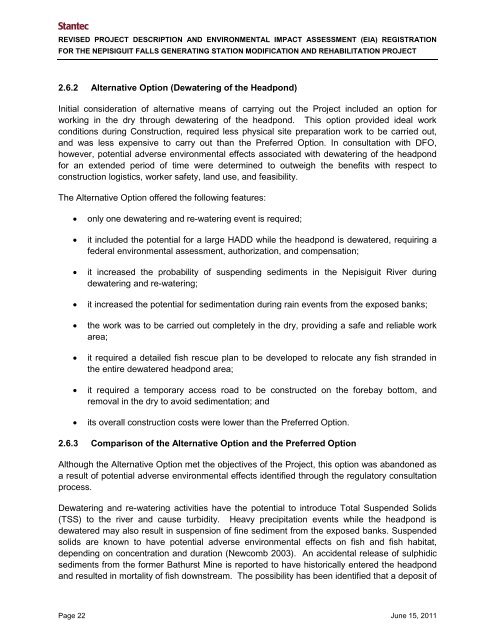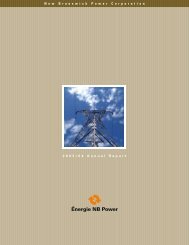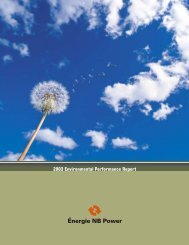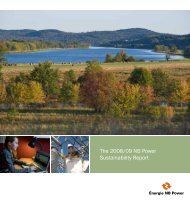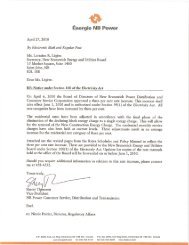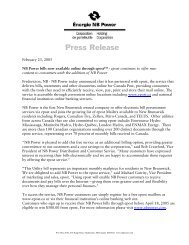Environmental Impact Assessment(EIA) Registration for the ...
Environmental Impact Assessment(EIA) Registration for the ...
Environmental Impact Assessment(EIA) Registration for the ...
You also want an ePaper? Increase the reach of your titles
YUMPU automatically turns print PDFs into web optimized ePapers that Google loves.
REVISED PROJECT DESCRIPTION AND ENVIRONMENTAL IMPACT ASSESSMENT (<strong>EIA</strong>) REGISTRATION<br />
FOR THE NEPISIGUIT FALLS GENERATING STATION MODIFICATION AND REHABILITATION PROJECT<br />
2.6.2 Alternative Option (Dewatering of <strong>the</strong> Headpond)<br />
Initial consideration of alternative means of carrying out <strong>the</strong> Project included an option <strong>for</strong><br />
working in <strong>the</strong> dry through dewatering of <strong>the</strong> headpond. This option provided ideal work<br />
conditions during Construction, required less physical site preparation work to be carried out,<br />
and was less expensive to carry out than <strong>the</strong> Preferred Option. In consultation with DFO,<br />
however, potential adverse environmental effects associated with dewatering of <strong>the</strong> headpond<br />
<strong>for</strong> an extended period of time were determined to outweigh <strong>the</strong> benefits with respect to<br />
construction logistics, worker safety, land use, and feasibility.<br />
The Alternative Option offered <strong>the</strong> following features:<br />
• only one dewatering and re-watering event is required;<br />
• it included <strong>the</strong> potential <strong>for</strong> a large HADD while <strong>the</strong> headpond is dewatered, requiring a<br />
federal environmental assessment, authorization, and compensation;<br />
• it increased <strong>the</strong> probability of suspending sediments in <strong>the</strong> Nepisiguit River during<br />
dewatering and re-watering;<br />
• it increased <strong>the</strong> potential <strong>for</strong> sedimentation during rain events from <strong>the</strong> exposed banks;<br />
• <strong>the</strong> work was to be carried out completely in <strong>the</strong> dry, providing a safe and reliable work<br />
area;<br />
• it required a detailed fish rescue plan to be developed to relocate any fish stranded in<br />
<strong>the</strong> entire dewatered headpond area;<br />
• it required a temporary access road to be constructed on <strong>the</strong> <strong>for</strong>ebay bottom, and<br />
removal in <strong>the</strong> dry to avoid sedimentation; and<br />
• its overall construction costs were lower than <strong>the</strong> Preferred Option.<br />
2.6.3 Comparison of <strong>the</strong> Alternative Option and <strong>the</strong> Preferred Option<br />
Although <strong>the</strong> Alternative Option met <strong>the</strong> objectives of <strong>the</strong> Project, this option was abandoned as<br />
a result of potential adverse environmental effects identified through <strong>the</strong> regulatory consultation<br />
process.<br />
Dewatering and re-watering activities have <strong>the</strong> potential to introduce Total Suspended Solids<br />
(TSS) to <strong>the</strong> river and cause turbidity. Heavy precipitation events while <strong>the</strong> headpond is<br />
dewatered may also result in suspension of fine sediment from <strong>the</strong> exposed banks. Suspended<br />
solids are known to have potential adverse environmental effects on fish and fish habitat,<br />
depending on concentration and duration (Newcomb 2003). An accidental release of sulphidic<br />
sediments from <strong>the</strong> <strong>for</strong>mer Bathurst Mine is reported to have historically entered <strong>the</strong> headpond<br />
and resulted in mortality of fish downstream. The possibility has been identified that a deposit of<br />
Page 22 June 15, 2011


